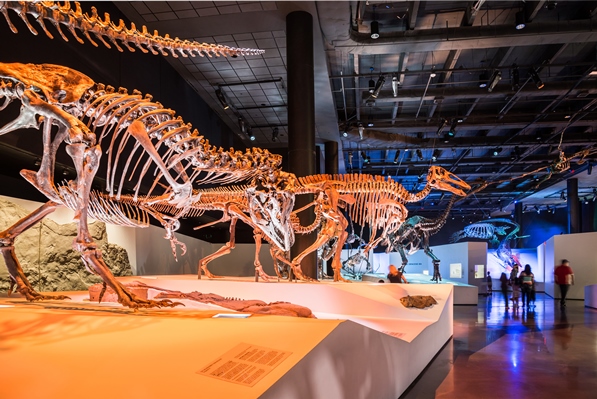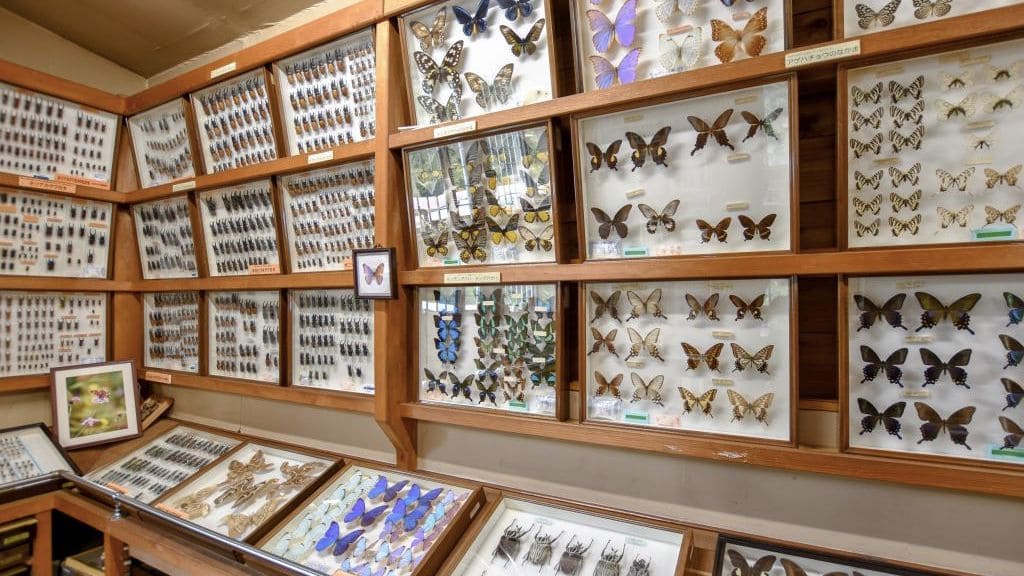If you’ve ever marveled at the intricate world of insects, you’re not alone. These fascinating creatures, with their diverse forms and behaviors, have captivated scientists and nature enthusiasts alike. But what if you could delve deeper into the world of bugs, exploring their beauty and complexity up close? Across the United States, a number of museums offer just that—a chance to immerse yourself in the enchanting realm of insects.
Imagine strolling through a vibrant butterfly pavilion, where thousands of butterflies flutter around you, or peering into a beehive to observe the intricate workings of these vital pollinators. From interactive exhibits to educational programs, these museums provide a unique opportunity to appreciate the critical roles insects play in our ecosystem. They transform what many might see as creepy crawlies into awe-inspiring subjects of study.
Whether you’re a curious family looking for a day out, a dedicated entomologist, or simply someone with a burgeoning interest in these small wonders, these museums offer something for everyone. With captivating displays and engaging activities, they turn the world of insects into an accessible and thrilling adventure.
The Harrell House Bug Museum: A Hidden Gem in Santa Fe

Overview
Located in the vibrant city of Santa Fe, New Mexico, The Harrell House Bug Museum is a treasure trove for insect enthusiasts. What started as a small mall kiosk in 2012 has grown into a comprehensive collection showcasing over 2,400 mounted insects from around the globe.
Exhibits and Attractions
- The Crawlywood Collection: This extensive exhibit features a diverse array of mounted insects, including butterflies, beetles, and more, from different continents.
- Live Specimens: Visitors can interact with over 150 live critters such as spiders, scorpions, and millipedes.
- Interactive Experiences: The museum staff often allows guests to hold or pet some of the friendlier insects, providing a hands-on learning experience.
Personal Insight
During my visit to The Harrell House Bug Museum, I was particularly impressed by the detailed and well-curated exhibits. The collection’s depth and diversity offer a fantastic opportunity to observe insects from different environments and ecosystems. The interactive component, where visitors can engage with live specimens, adds an enriching, personal touch to the experience.
The Houston Museum of Natural Science: A Texas Giant

Overview
The Houston Museum of Natural Science in Houston, Texas, is renowned for its extensive natural history exhibits. Among its many attractions, the museum features an impressive insect zoo and the Cockerel Butterfly Center, making it a must-visit for insect aficionados.
Exhibits and Attractions
- Brown Hall of Entomology: This hall is divided into three levels, each offering a unique perspective on the world of insects:
- Insects and Us!: An interactive learning center with interviews and close-up views of various specimens.
- The Land of Beeyond: A child-friendly environment designed to immerse visitors in the world of insects.
- The Amazing World of Arthropods: Showcasing live insects such as leaf cutter ants, giant cockroaches, and more.
- Cockerel Butterfly Center: A walk-through habitat where visitors can experience a tropical butterfly environment.
Personal Insight
The Houston Museum of Natural Science stands out for its educational approach and the breadth of its exhibits. The multi-level setup in the Brown Hall of Entomology allows visitors to explore insects from different angles, making it an excellent destination for both casual visitors and serious enthusiasts. The Butterfly Center adds a vibrant touch to the experience, creating a lush, immersive environment.
Monsanto Insectarium at Saint Louis Zoo: A Comprehensive Exploration

Overview
The Monsanto Insectarium at the Saint Louis Zoo offers a comprehensive and engaging look into the world of insects. With more than 20 exhibition areas, it provides a thorough exploration of insect diversity and behavior.
Exhibits and Attractions
- Live Insect Displays: Over 100 species of live insects are showcased in educational environments.
- Interactive Exhibits: Visitors can peek inside a working beehive and view impressive insect sculptures, such as the eight-foot Centaurus beetle.
- Mary Ann Lee Butterfly Wing: This domed exhibit features dragonflies, moths, and other winged invertebrates.
Personal Insight
The Monsanto Insectarium excels in combining educational content with engaging displays. The live exhibits are particularly noteworthy, providing an up-close look at a wide range of insect species. The interactive elements, such as the beehive and insect sculptures, add an extra layer of interest and make for an enjoyable visit.
The Bug Museum: A Washington Wonder

Overview
Situated in Bremerton, Washington, The Bug Museum offers a unique blend of bug and reptile exhibits. This museum is a great place to explore a variety of insects and learn about their ecological roles.
Exhibits and Attractions
- Ant Farm Display: An eight-foot-long ant farm showcases the intricate social structure and behavior of ants.
- Live Insects: Familiar species like the praying mantis and tarantula, as well as less common critters such as the blue death-feigning beetle.
- Educational Videos and Microscopes: Visitors can watch bug-related videos and study insects under microscopes.
Personal Insight
The Bug Museum in Bremerton offers a delightful combination of education and entertainment. The ant farm is a standout exhibit, providing a fascinating look at ant colonies in action. The opportunity to view insects under a microscope adds a scientific touch to the visit, making it both fun and informative.
Philadelphia Insectarium and Butterfly Pavilion: A Multi-Faceted Experience

Overview
The Philadelphia Insectarium and Butterfly Pavilion has been a popular family attraction since its opening in 1992. This museum features a range of exhibits that highlight the beauty and diversity of insects.
Exhibits and Attractions
- Butterfly Pavilion: A tropical ecosphere housing thousands of butterflies, offering a vibrant and colorful experience.
- Chrysalis Chamber: A space dedicated to observing the transformation of caterpillars into butterflies.
- Honey Bee Center: Provides insight into the life of bees and their importance to ecosystems.
- Insect and Arachnid Showcase: Features tarantulas, praying mantis, scorpions, and other arthropods.
Personal Insight
The Philadelphia Insectarium and Butterfly Pavilion is a standout destination for families and insect enthusiasts. The Butterfly Pavilion is particularly impressive, with its lush environment and diverse butterfly species. The museum’s range of exhibits ensures there’s something for everyone, from interactive displays to educational presentations.
Smithsonian National Museum of Natural History: An Entomological Treasure
Overview
The Smithsonian National Museum of Natural History in Washington, D.C., houses the O. Orkin Insect Zoo, a major attraction for those interested in insects. This museum is part of the Smithsonian Institution, known for its extensive and well-curated collections.
Exhibits and Attractions
- O. Orkin Insect Zoo: Features over 300 live insects and several recreated habitats, including a Sonoran Desert and Tropical Rain Forest.
- African Termite Mound: A towering exhibit that showcases the intricate construction of termite mounds.
- Tarantula Feeding Demonstrations: Scheduled events where visitors can witness tarantulas in action.
Personal Insight
The Smithsonian’s O. Orkin Insect Zoo offers a rich and educational experience. The recreated habitats are particularly impressive, providing context for the insects’ natural environments. The tarantula feeding demonstrations are a highlight, offering a rare opportunity to see these fascinating creatures up close.
Insectarium at Audubon Nature Institute: A New Orleans Favorite

Overview
Located in downtown New Orleans, the Insectarium at Audubon Nature Institute is a popular attraction housed in a historic U.S. Custom House. This museum offers a diverse range of exhibits and interactive experiences.
Exhibits and Attractions
- Termite Gallery: An exhibit dedicated to the world of termites, including their role in ecosystems.
- Recreated Wetlands Habitat: Showcases aquatic insects and reptiles in a simulated environment.
- Underground Installation: Provides a unique perspective on the world from an ant’s viewpoint.
- Bug Appetit Exhibit: Features culinary uses of insects, with dishes available for tasting.
Personal Insight
The Insectarium at Audubon Nature Institute is a fascinating destination with its blend of educational and interactive exhibits. The Bug Appetit exhibit, in particular, offers an intriguing look at how insects can be incorporated into cuisine. The variety of displays ensures that visitors leave with a deeper appreciation for the role of insects in our world.
FAQs: Museums for Insect Lovers
1. What can I expect to see at an insect museum?
Insect museums offer a variety of exhibits and experiences, including:
- Mounted Insects: Collections of preserved insects from around the world, showcasing their diversity.
- Live Insects: Interactive displays with live specimens such as butterflies, beetles, and arachnids.
- Educational Exhibits: Information on insect behavior, ecology, and their roles in ecosystems.
- Interactive Components: Opportunities to handle insects, observe them up close through microscopes, or experience their habitats.
2. Are these museums suitable for children?
Yes, many insect museums are family-friendly and offer exhibits tailored for children. Interactive displays, hands-on activities, and educational programs are often designed to engage younger audiences. Museums such as the Philadelphia Insectarium and Butterfly Pavilion and the Harrell House Bug Museum provide child-friendly experiences that make learning about insects fun and educational for kids.
3. Can I handle live insects at these museums?
Handling live insects depends on the museum’s policies and the specific exhibit. Museums like The Harrell House Bug Museum and the Houston Museum of Natural Science often offer opportunities for visitors to interact with friendly insects under supervision. Always check with the museum staff for guidelines on handling live specimens.
4. Do I need to book tickets in advance?
Ticket policies vary by museum. Some museums may require advance booking, especially during peak times or for special events. It’s a good idea to check the museum’s website or contact them directly to find out if reservations are needed and to purchase tickets in advance if necessary.
5. Are there any special events or programs at these museums?
Yes, many insect museums host special events, educational programs, and temporary exhibits. For example:
- The Smithsonian National Museum of Natural History regularly holds tarantula feeding demonstrations.
- The Monsanto Insectarium at the Saint Louis Zoo features educational programs and interactive workshops.
- The Insectarium at Audubon Nature Institute offers unique exhibits like the Bug Appetit, which explores edible insects.
Conclusion
Each of these insect museums offers a unique and engaging way to explore the world of insects. From interactive exhibits and live displays to educational programs and culinary adventures, these destinations provide valuable insights and unforgettable experiences. As an entomologist, I encourage everyone to visit these museums and discover the remarkable diversity and importance of insects firsthand.

